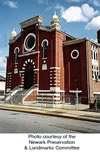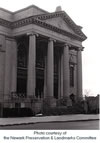Three ancient buildings that started as
synagogues in Newark's old Third Ward remain as a testimony to the
once thriving Newark Jewish community which peaked at nearly 58,000
in the late 1940's.
The oldest of the three buildings, currently referred to as "The
Prince Street Synagogue," was an early building of the Congregation
Oheb Shalom, which was established by German-Jewish immigrants in
1860.
After its congregants had met for years on the top floor of a
dwelling at 25-27 Prince Street, between Springfield and South Orange
Avenues, the landmark structure was erected in 1884 at No. 30 Prince
Street, and its congregants worshipped there until the fall of 1911.
The building is on the Register of National Historic Places and
is the oldest standing synagogue building in Essex County.
In 1911, the Congregation Oheb Shalom left its 30 Prince Street
building and moved to a new, greatly enlarged building at 672 High
Street, between Montgomery and West Kinney Streets. The new site
faced the eastern edge of the Third Ward, where most of Newark's
rapidly-growing Jewish community resided.
The congregation worshiped in the 672 High Street building until
1957, when it moved to its present location in South Orange.
The third synagogue building was the Temple B'nai Jeshurun at
783 High Street, corner of Waverly Avenue. It is New Jersey's oldest
Jewish congregation, incorporated in 1847. This Third Ward High
Street structure was occupied in 1914, and the congregation worshipped
at that location until 1958, when it moved to its present location
in Millburn/Short Hills.
About the Prince Street Synagogue
The Oheb Shalom building at 30 Prince Street was in stark contrast
to the wood frame buildings on its block. It was a handsome Moorish
Revival-style building of red brick with white trim. Its exterior
was
 topped
with cone-topped minarets and keyhole-shaped windows of stained
glass. topped
with cone-topped minarets and keyhole-shaped windows of stained
glass.
When the Oheb Shalom congregation vacated 30 Prince Street in
1911, it was occupied by Congregation Adas Israel. This congregation
used the building until 1939.
I recall attending the Adas Israel religious school in 1931.
The Metropolitan Baptist Church bought the building in 1949 and
its congregants worshipped there for 54 years before moving to a
larger building in 1993.
When the building fell into disrepair in the late 1990's and was
threatened with demolition, it was taken over by the Greater Newark
Conservancy. It has since been undergoing a targeted $4.2 million
restoration after which it will become the headquarters for the
Conservancy.
The restoration work on the outside of the building has already
been completed, including the addition of a new roof. The interior
restoration is expected to be completed by the end of 2003.
The Oheb Shalom High Street Building
The Oheb Shalom High Street building at No. 672 was a handsome
white stone Neo-Classic style building. Its dedication was Presided
over by its rabbi, Charles I. Hoffman1.
Also at the dedication were the Governor of New Jersey, Woodrow
Wilson, and Solomon Schechter, head of the Jewish Theological Seminary
and a Jewish leader of world renown.
By the time of its dedication, its membership consisted of more
 native-born Americans than immigrants.
native-born Americans than immigrants.
From 1924 on, the High Street Oheb Shalom building was just across
a vacant lot from the YM-YWHA at No. 652 on the corner of West Kinney
Street.
During my youth I recall attending Succoth celebrations (Jewish
harvest festival) in its permanent wood-slatted sukka, attached
to the left side of the building.
Since being vacated by the Oheb Shalom congregation, it has been
occupied as a house of worship by The Church of God in Christ Tabernacle.
Temple B'nai Jeshurun
Temple B'nai Jeshurun was originally founded as an Orthodox congregation,
but by the time it had moved into its third Newark site at 783 High
Street, just off Clinton Avenue, it had become Reform2.
The building was a magnificent domed structure. The building's
huge round dome dominated the skyline for that part of Newark and
was recognizable from miles away.
I recall visiting the building in 1955 for the wedding of my younger
brother, Al, and his wife, Betty, and I recall being struck by the
beauty of the exquisite stained glass windows, depicting Biblical
scenes. The building interior, itself, was plush, although its life
as a Jewish house of worship had only two more years before the
'leap-frog' from the Third Ward to Short Hills.
The building today serves African-American worshipers as the Hopewell
Baptist Church.
High Street Historic District
Both of the High Street former synagogue buildings are part of
Newark's "High Street Historic District."
|

